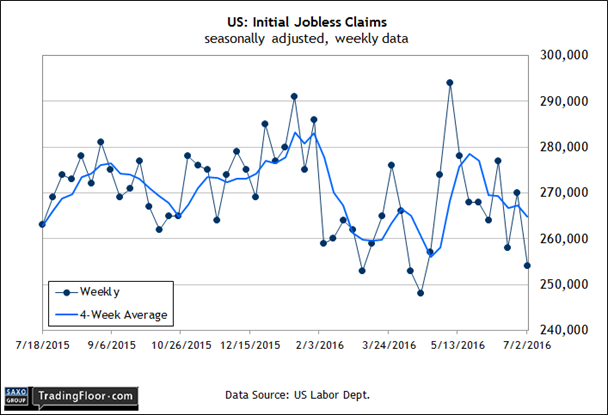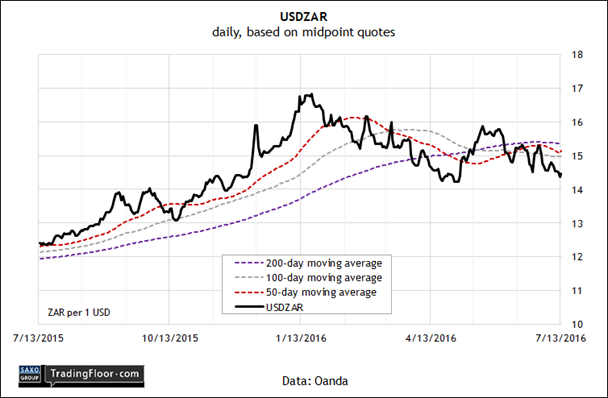- The Bank of England is expected to cut rates for the first time in seven years
- US jobless claims projected to rise but stick close to multi-decade lows
- Will slower growth derail this year's rally in the South African rand vs. the US dollar?
The Bank of England’s policy announcement will dominate the headlines today as markets brace for what’s expected to be the first rate cut for the UK in seven years. Later, the weekly update on US jobless claims arrives.
Meanwhile, keep your eye on the South African rand, which continues to show strength against the US dollar despite economic headwinds and heightened political uncertainty in Africa’s largest economy.
UK: Bank of England Announcement and Minutes (1100 GMT): The Bank of England is expected to officially react to a post-Brexit world today by cutting interest rates by 25 basis points. If the crowd is right, the dip in the central bank’s policy rate will be the first cut in seven years.
The key factor behind the decision is the forecast that Britain is at high risk of slipping into a new recession in the wake of last month’s vote to leave the European Union. “Our base case is we will have a recession,” according to the chief investment strategist at BlackRock, the world's largest asset manager. “There's likely to be a significant reduction of investment in the UK,” in no small part because Brexit has heightened political and economic uncertainty.
BlackRock is hardly alone in forecasting economic contraction for the UK. Analysts at Barclays, Credit Suisse and JP Morgan recently projected a new downturn in the months ahead, according to PoundSterling Live. Daiwa Capital Markets said in a note to clients that “recession looks inevitable”.
Mark Carney, Governor at the Bank of England, has a history of pre-emptive policy decisions, which is a factor in the widespread estimates that he’ll announce a rate cut today. Econoday.com’s consensus forecast sees the policy rate falling 25 basis points to 0.25%.
“One thing Carney is very good at doing is jumping ahead of the curve,” an economist at TD Securities in London told Bloomberg this week. “As governor of the Bank of Canada, he was cutting rates dramatically before Lehman went bust,” noted James Rossiter, a former official at the BoE and the Bank of Canada. “To have that sort of foresight, to know this was going to be a bigger issue than perhaps the markets were appreciating, and to go forth on a clear easing strategy, is something that we could see him repeating.”
US: Initial Jobless Claims (1230 GMT): Optimism on the US outlook for the labour market is expected to receive another boost today in the weekly numbers for jobless claims.
New filings for unemployment benefits are expected to rise by 11,000 to a seasonally adjusted 265,000 for the week through July 9, according to Econoday.com’s consensus forecast. But even a modest rise will continue to leave claims near multi-decade lows. Economists say that any reading below 300,000 reflects a healthy labour market.
By that standard, today’s release is expected to reaffirm the upbeat news in last week’s monthly data for June payrolls, which rebounded sharply with a rise of 287,000 – the strongest monthly advance in eight months.
Note, however, that the Federal Reserve’s Labor Market Conditions Index has been printing negative all year through June. This multi-factor benchmark ticked higher last month, but the year-to-date trend implies that job growth is slowing, perhaps substantially more so than the June payrolls data suggests.
But if there’s still a debate about where the labour market’s headed in the second half of 2016, economists are expecting that today’s figures for claims will continue to anticipate a healthy expansion for the foreseeable future.

USD/ZAR: Is the tangled state of macro and politics in South Africa poised to derail this year’s bull run for the rand against the US dollar?
“The deteriorating competitiveness of South Africa and the populist government of Jacob Zuma is the reason why I’m convinced we’ll see a weaker rand over the year,” advised an analyst at Landesbank Baden-Wuerttemberg. “I am pretty pessimistic about the political cost of South Africa,” Matthias Krieger told Bloomberg this week.
The rand, however, has yet to show any material signs of weakness in terms of the greenback. USD/ZAR is trading near its lowest level in two months. Year to date, the dollar is down by more than 7% vs. the rand.
The outlook for South Africa’s economy, however, paints a mixed picture at best. The International Monetary Fund last week pared its growth forecast to 0.1% for 2016, down from the 0.6% outlook published in May. “Downside risks dominate and stem mainly from China, heightened global financial volatility, and domestic politics and policies that may reduce confidence,” the IMF advised.
Yet this year’s rally in the rand shows few signs of reversing at the moment, in part because the latest retail sales and manufacturing reports delivered upbeat news. Spending increased 4.5% in May vs. the year-earlier level – the strongest gain since January 2014 – and manufacturing advanced 4.0% year over year, the best performance in 10 months. The news suggests that the first-quarter GDP slide in South Africa may be the low point for the macro news in the near term.
Although analysts are generally projecting weak growth, that may suffice to keep the rand steady against the dollar. If so, that leaves the rand’s bears looking to political turmoil surrounding President Zuma’s administration as the leading factor that could derail the currency’s strength.

Disclosure: Originally published at Saxo Bank TradingFloor.com
